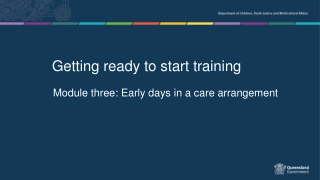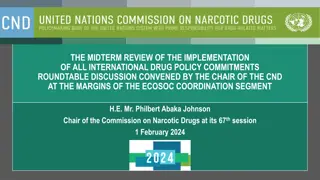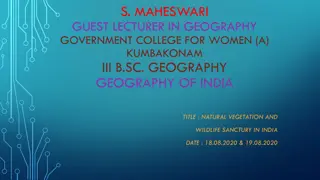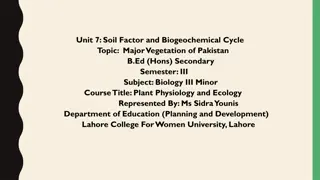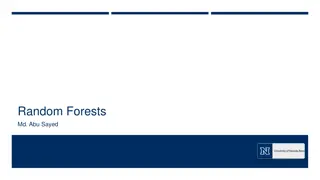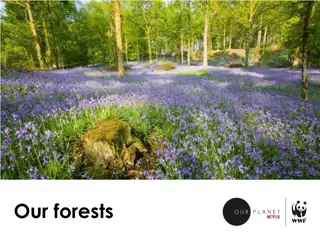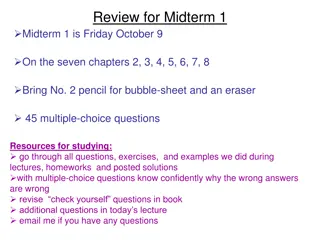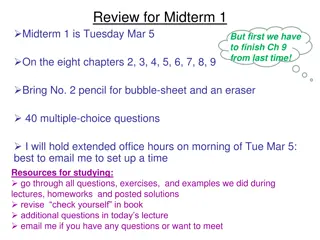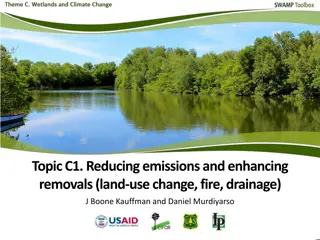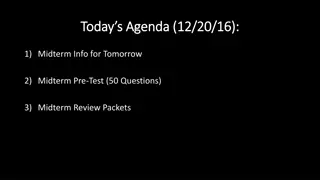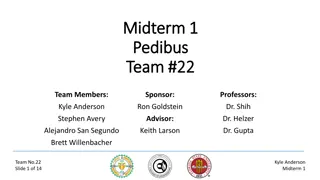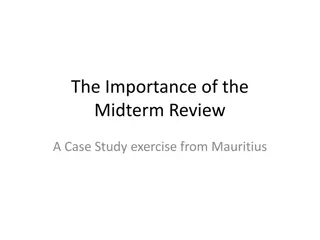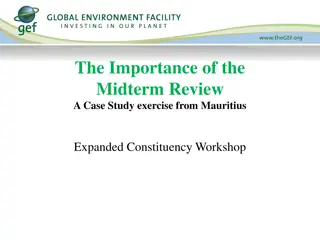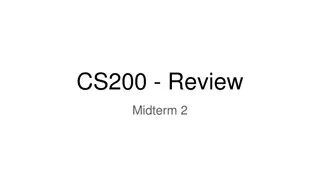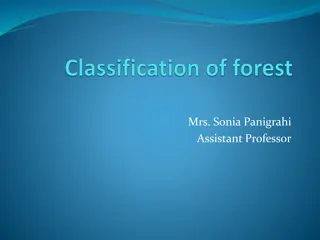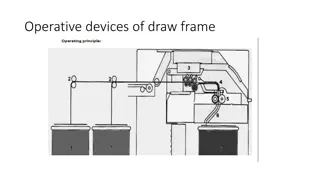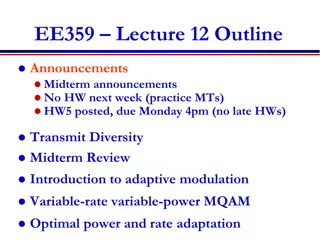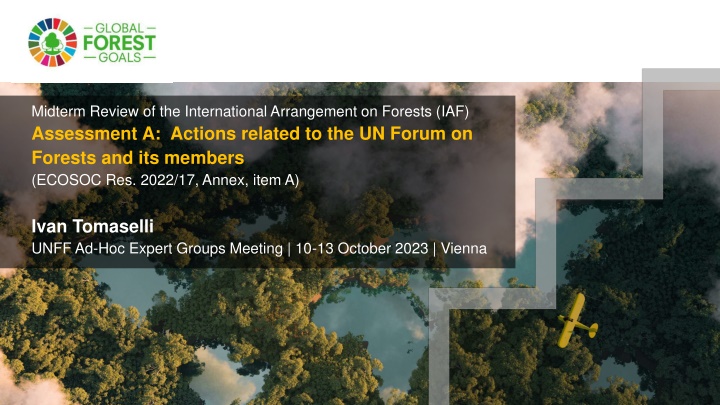
Midterm Review of International Arrangement on Forests: Actions & Progress
The mid-term review assesses actions related to the UN Forum on Forests & its members, analyzing progress towards global forest goals, member engagement, and effectiveness recommendations. It highlights challenges faced in achieving objectives, such as the non-binding nature of the UN Forest Instrument. The review also evaluates transparent operation, capacity building efforts, stakeholder involvement, and suggestions for improvement.
Download Presentation

Please find below an Image/Link to download the presentation.
The content on the website is provided AS IS for your information and personal use only. It may not be sold, licensed, or shared on other websites without obtaining consent from the author. If you encounter any issues during the download, it is possible that the publisher has removed the file from their server.
You are allowed to download the files provided on this website for personal or commercial use, subject to the condition that they are used lawfully. All files are the property of their respective owners.
The content on the website is provided AS IS for your information and personal use only. It may not be sold, licensed, or shared on other websites without obtaining consent from the author.
E N D
Presentation Transcript
Midterm Review of the International Arrangement on Forests (IAF) Assessment A: Actions related to the UN Forum on Forests and its members (ECOSOC Res. 2022/17, Annex, item A) Ivan Tomaselli UNFF Ad-Hoc Expert Groups Meeting | 10-13 October 2023 | Vienna
Presentation Outline Brief introduction Assessment and findings Recommendations 2
Introduction Actions involving the Assessment A of the UNFF and its Members Assess the progress made by the UNFF and its members towards the objectives of the international arrangement on forests (IAF) / ECOSOC Res. 2015/33. 1. Analyze the Forum's performance, its impact on global forest policy and on the work of high-level political forum (HLPF) on sustainable development, to increase its effectiveness. 2. Explore measures to enhance annual Forum sessions and member participation in intersessional activities to foster the achievement of the global forest goals (GFGs). 3. Identify means to encourage the submission of more VNRs and to encourage increased VNCs and promote their effectiveness. 4. To carry out the above-mentioned tasks to submit it to the open-ended intergovernmental AHEG (Ad hoc Expert Group). 3
Sources of Information 1. Review of documents/info on UN-related websites (UNFF, UNDESA, ECOSOC), other relevant publications; 2. Review of documents/info provided by UNFFS; 3. Responses to consolidated survey developed by Consultants to gather views from UNFF member states, CPF members, and relevant stakeholders on actions A to J (Annex to ECOSOC Res. 2022/17) Survey included 6 questions on Assessment A Total of 26 contributions all of them responded to assessment A 4. Additionally: Direct contact (via e-mail / telephone) with the UNFF focal points of selected countries, considering the most forested countries / impact on global timber trade. 4
Conclusions The assessment and findings are considered in six main themes 1. Progress made by the UNFF and its Members towards the objectives of the IAF 2. IAF Objectives with less or no progress 3. The IAF beyond 2015 operating in a transparent, effective, efficient, and accountable manner 4. Progress made by UNFF considering its core functions (Resolution 2015/33, para. 3) Level of engagement of Members and Stakeholders in the Forum s intersessional activities and suggestions to improve UNFF s annual sessions Encourage more UNFF Members to submit voluntary national reports (VNRs) and voluntary national contributions (VNCs) 5. 6. 5
1. Progress made by the UNFF and its Members towards the objectives of the IAF Overall, UNFF has provided capacity building to member states and developed the financial and technical assistances. The relevant conclusions are: The non-binding nature of UNFI (UN Forest Instrument) is the main challenge to achieving progress, which depends on the political will and engagement of member states UNFF members have focused mainly on the legal fields There is a lack of involvement of senior political leaders in the decision-making process on forestry agendas, and a need to increase efforts to achieve the GFGs The importance of HLPF on forest agendas to develop and institutionalize forest policies through national programs has not been properly emphasized 6
2. IAF Objectives with less or no progress In general, progress has been made on all objectives. Nevertheless, Members mention that none of them have been effectively achieved due to insufficient financial, technical and technological support. IAF objectives with least advances are: Cooperation and synergies on forest related issues at all levels; International cooperation at all levels; Strengthening forest governance frameworks and means of implementation, according to UNFI, to achieve SFM. The main weakness on achieving the IAF goals is the inconsistent participation in stakeholders and member states engagement. It is needed to: Foster regional cooperation (North-South, South-South, triangular cooperation at all levels) Guide public forest policies towards alternatives to SFM that integrates society's controllers Increase efforts to support low-GDP countries in terms of financial and technical support Strengthen forest governance structures 9
3. The IAF beyond 2015 operating in a transparent, effective, efficient, and accountable manner Overall, the IAF's operation was recognized by Member States as transparent, effective, efficient and accountable. UNFF has made efforts to reach out Member States and provide support to the program in implementing UNSPF In spite of that, it was mentioned: A lack of means to track the progress of the member states in achieving the IAF goals Need to improve efficiency in communication among member states That UNFF organizational structure and its tasks should be more transparent, and its actions shared, e.g. the work done during the annual sessions and the inter-sessional period 8
4. Progress made by UNFF considering its core functions Function a): To provide a coherent, open, transparent and participatory global platform for [ ] The UNFF global platform, its annual meetings according to Member States are fundamental tools for policy dialogue and intergovernmental cooperation on SFM Function b): To promote, monitor, assess the implementation of SFM [ ] VNCs are an opportunity to share and monitor progress made by member states Function c): To mobilize, catalyze, and facilitate access to financial, technical and scientific resources In general, GFFFN assist countries to mobilize resources and access to funds for forests to improve cooperation between developed and developing countries Function (d): To promote governance frameworks to achieve SFM UNFF has made efforts to fostering dialogue, knowledge exchange among countries, policy guidelines and promoting governance structures, but Member States mentioned to be important to further consider the role of the private sector to achieve SFM Function (e): To strengthen high-level political engagement [ ] in support of SFM UNFF is providing input into HLPF, ministerial statement, CPF and major groups input at the UNFF sessions to support SFM, but this is needed to be strengthened. 9
5. Level of engagement in the intersessional activities and suggestions to improve UNFF s annual sessions The level of engagement in the intersessional activities was considered by Member States as low. It can be attributed to: Lack of resources to participate in the UNFF meetings Positioning of member states, such as their own potential, availability, and restriction of the Forum's discussions due to the scheduling constraints Some suggestions were made, including: Increase the engagement by focusing into potential concrete/tangible actions Use of hybrid meeting, including online formats, for intersessional activities Increase opportunities for exchange of experiences among region-countries 10
6. Encourage more UNFF Members to submit VNRs & VNCs Members suggested to: Simplify the reporting format Facilitate the evaluation of key indicators to avoid becoming a costly activity and eventually member countries need financial support to prepare their reports Increase support and technical capacity building for countries to prepare their reports Create a single online platform, allowing filling of the information in phases and with approval by the responsible institutions Share successful SFM cases at the regional level 11
Recommendations Urge UNFF Members to be more active in implementing the UNSPF and the GFGs in high-level political dialogues, working in synergy with other initiatives, such as ITTO, UNFCCC, CBD, CCD, dealing with SFM Improve political leaders and stakeholders effective engagement, fully integrating them in the discussions and decision-making processes Promote cross-sectoral cooperation between developed and developing countries at all levels (financial support, knowledge, technologies, capacity- building) 1. Progress made by the UNFF and its Members Support efforts to strengthen forest governance structures and means of implementation Promote a greater stakeholders engagement to achieve IAF objectives Strengthen the coordination and working agendas of the UNSPF goals, other multilateral agreement, bilateral cooperation that have an agenda on SFM Improve cooperation at all levels 2. IAF Objectives with less or no progress 12
Recommendations 3. The IAF beyond 2015 operating in a transparent, effective, efficient & accountable manner Improve efficiency in communication among Member States and the UNFF secretariat by designating a focal point for communication Explore other adequate means to follow-up on the progress of member states Increase transparency of the UNFF s work Raise its political level to be more strategic, e.g. UNFF inputs into HLPF sessions, reaching other sectors and increasing relevance in promoting SFM Establish a clearing house in an interactive platform for exchange of lessons learned and best practices Further enhance technical and financial support to subnational and local institutions 4. Progress made by UNFF considering its functions 13
Recommendations 5. Level of engagement in the intersessional activities and suggestions to improve UNFF s annual sessions Use hybrid meeting formats for intersessional activities, increasing opportunities for sharing experiences among countries Increase VNCs visibility and sharing of successful SFM cases at the regional level trough online platforms, social networks, and presentation during forum sessions 6. Encourage more UNFF Members to submit VNRs and VNCs Continuously keep simplifying the reporting format for VNCs Facilitate the monitoring indicators of the GFGs because it can become a costly activity Reduce number of questions of VNRs, including open-ended questions to allow flexibility to answer the questions 14
Thank You! A copy of this PPT is available on the UNFF website at: https://www.un.org/esa/forests/events/aheg-iaf-mtr/index.html itomaselli@stcp.com.br www.stcp.com.br

